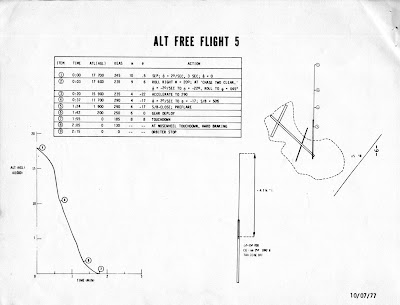Before the space shuttle commenced operations, NASA validated the airworthiness of the orbiter design in a series of test flights. The initial flights were “captive” tests, mounted on the Shuttle Carrier Aircraft (SCA), NASA’s modified Boeing 747. From 12 August 1977, the captive flights were followed by five free flights in which Enterprise was released from her mother ship to fly free to a landing at Edwards Air Force Base in the Californian desert.
NASA planned that after these Approach and Landing Tests (ALT), Enterprise would spend a year undergoing vibration tests to verify other aspects of the shuttle design and would then be returned to Rockwell International (today part of Boeing) to be refurbished for orbital flight. This refurbishment never took place (a ground test airframe was refurbished instead to become Challenger) and the only times Enterprise took to the air again was as cargo atop the SCA on her way to various exhibition sites. These destinations included the 1983 Paris Air Show, the 1984 Louisiana World Exposition, the Smithsonian National Air and Space Museum, and the Intrepid Sea, Air & Space Museum, Enterprise’s current home.
Each of the Approach and Landing Tests was a little more ambitious than the one that went before. They began with Enterprise fitted with a streamlined tailcone covering the blunt rear end of the shuttle where the main engines were designed to fit, and with the shuttle descending to land on a dry lake bed with plenty of margin for error. By the fifth flight, of 26 October 1977, Enterprise was flying without the tailcone, with dummy main engines in place, and headed for touchdown on a conventional concrete runway.
It would be the worst landing of the whole shuttle program.
The NASA press release describes the test as planned for that day:

| 
|

| 
|

| 
|
Coming in slightly fast, Enterprise missed the intended touchdown point, landed long, bounced back into the air, then started to roll before the crew brought her back down safely.
This video shows the landing:
Lag in the responsiveness of the flight control system, together with the generally poor visibility from the Shuttle’s flight deck, had led the crew (commander Fred Haise and pilot Gordon Fullerton) into a series of overcorrections or “pilot-induced oscillation” (PIO).
As a result, after this test, the flight control system software was modified to counteract the tendency for pilots to overcorrect in this way, at the expense of a little control sensitivity.
Copyright information: the press kit is a work of NASA. As a work of the US federal government, it is in the public domain.



No comments:
Post a Comment